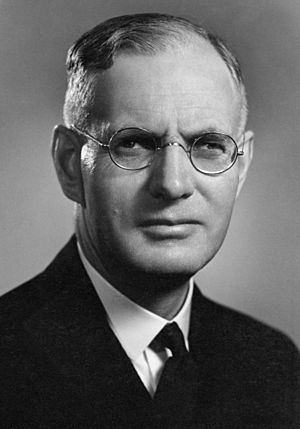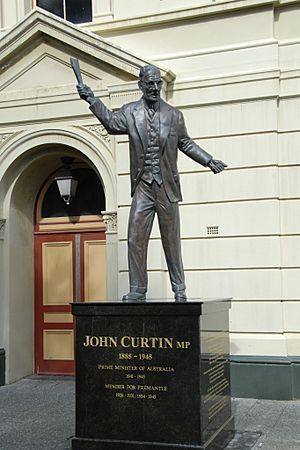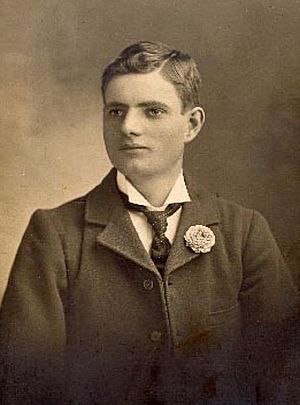John Curtin facts for kids
Quick facts for kids
John Curtin
|
|
|---|---|
 |
|
| 14th Prime Minister of Australia | |
| In office 7 October 1941 – 5 July 1945 |
|
| Monarch | George VI |
| Governor-General | Lord Gowrie Prince Henry, Duke of Gloucester |
| Preceded by | Arthur Fadden |
| Succeeded by | Frank Forde |
| Minister for Defence | |
| In office 7 October 1941 – 5 July 1945 |
|
| Prime Minister | Himself |
| Preceded by | Robert Menzies |
| Succeeded by | Jack Beasley |
| Leader of the Opposition | |
| In office 1 October 1935 – 7 October 1941 |
|
| Prime Minister | Joseph Lyons Earle Page Robert Menzies Arthur Fadden |
| Deputy | Frank Forde |
| Preceded by | James Scullin |
| Succeeded by | Arthur Fadden |
| Leader of the Australian Labor Party | |
| In office 1 October 1935 – 5 July 1945 |
|
| Deputy | Frank Forde |
| Preceded by | James Scullin |
| Succeeded by | Ben Chifley |
| Member of the Australian Parliament for Fremantle |
|
| In office 15 September 1934 – 5 July 1945 |
|
| Preceded by | William Watson |
| Succeeded by | Kim Beazley Sr. |
| In office 17 November 1928 – 19 December 1931 |
|
| Preceded by | William Watson |
| Succeeded by | William Watson |
| Personal details | |
| Born |
John Joseph Ambrose Curtin
8 January 1885 Creswick, Victoria |
| Died | 5 July 1945 (aged 60) Canberra, ACT, Australia |
| Resting place | Karrakatta Cemetery |
| Political party | Australian Labor Party |
| Other political affiliations |
Victorian Socialist Party |
| Spouse |
Elsie Needham
(m. 1917) |
| Relations | Ted Needham (brother-in-law) Claude Curtin (nephew) |
| Children | 2 |
| Signature | |
John Curtin (born 8 January 1885 – died 5 July 1945) was an important Australian politician. He served as the 14th Prime Minister of Australia from 1941 until his death in 1945. He was also the Leader of the Labor Party from 1935 to 1945.
Curtin first formed a government in 1941, but it was a minority government. This means his party did not have enough seats to rule alone. However, he led the Labor Party to a huge victory in the 1943 election. This was Labor's biggest win ever in a federal election.
As a Member of Parliament for Fremantle, Curtin was the first Prime Minister from outside Australia's eastern states. He is widely seen as one of Australia's greatest prime ministers. He successfully guided Australia when it was directly threatened by Japan during World War II. Curtin died in office in 1945, just as the war was ending.
Contents
John Curtin's Early Life and Career
John Curtin started working at a young age. In 1899, when he was about 14, he became an office boy for a magazine. He earned five shillings a week. His boss was the artist and writer Norman Lindsay.
After that, Curtin had many short-term jobs. He worked as a copy boy for a newspaper and as a potter's apprentice. He didn't get a steady job until he was 18. In 1903, he started working as a clerk for a manufacturing company. By then, he was the main person earning money for his family.
Curtin was a talented sportsman when he was young. From 1903 to 1907, he played Australian rules football for the Brunswick Football Club. His teammates called him "Bumble." He also played cricket and was known as a good batsman. He loved sports his whole life, as a supporter and administrator. People said he knew everything about cricket statistics.
From a young age, Curtin was active in politics. He joined both the Australian Labor Party and the Victorian Socialist Party. From 1911 to 1915, he worked as the Secretary of the Timberworkers' Union. In 1914, he ran as a Labor candidate for parliament. In 1917, he married Elsie Needham. Her brother, Ted Needham, was also a Labor Senator.
In 1917, Curtin moved to Cottesloe near Perth. He became the editor of the Westralian Worker, which was a newspaper for trade unions. He enjoyed the calmer life in Western Australia. He joined the Australian Journalists' Association and became its Western Australian President in 1920. He always wore his journalist's badge, even when he was Prime Minister. Curtin also strongly supported the rights of women and children.
Leading Australia During Wartime
John Curtin became Prime Minister in 1941, during World War II. This was a very difficult time for Australia. The nation faced a direct threat from Japan. Curtin's leadership was crucial in protecting Australia.
He worked closely with Allied leaders like Winston Churchill and Franklin D. Roosevelt. He made tough decisions to keep Australia safe and strong during the war. Under his leadership, Australia's military efforts were greatly expanded.
John Curtin's Death
By 1944, John Curtin's health was getting worse. He had heart disease. He was traveling a lot for meetings with other world leaders. In early 1945, his health rapidly declined.
On 5 July 1945, Curtin died at The Lodge in Canberra. He was 60 years old. He was the second Australian Prime Minister to die while still in office within six years. His body was flown back to Perth. Over 30,000 people attended his funeral at Karrakatta Cemetery in Perth. Many more lined the streets to pay their respects.
General Douglas MacArthur, an important Allied commander, said that "the preservation of Australia from invasion will be his immemorial monument." This means that saving Australia from invasion would be Curtin's lasting memory.
John Curtin's Legacy

John Curtin is remembered for leading the Australian Labor Party to its biggest federal election success ever. In the 1943 election, his party won two-thirds of the seats in the lower house of parliament.
One of Curtin's important achievements was greatly expanding social services. In 1942, a new tax system allowed his government to create many new social services. These included:
- Pensions for widows (1942).
- Maternity benefits for Indigenous Australians (1942).
- Funeral benefits (1943).
- Unemployment and sickness benefits (1945).
- Help with medicine costs (1945).
Pensions were also improved, and it became easier for people to qualify for them. Many other social security benefits were increased. One historian said that Australia went from having very few welfare programs before World War II to having a "welfare state" by the end of the war.

The Curtin government also passed the Statute of Westminster Adoption Act 1942. This law was very important because it marked Australia's legal independence from the United Kingdom. It is a key part of Australia's modern legal system.
Because he died early and was so respected, Curtin has a special place in Australian political history. Many Labor leaders after him have tried to follow his example. Even some politicians from other parties respect his legacy.
John Curtin is remembered in many ways across Australia:
- A federal voting area called the Division of Curtin.
- A suburb in Canberra called Curtin.
- Curtin University in Perth.
- The John Curtin College of the Arts in Fremantle.
- The John Curtin School of Medical Research in Canberra.
- The John Curtin Prime Ministerial Library.
- Many other buildings, roads, and parks.
In 1975, Australia Post honored Curtin with a postage stamp showing his portrait. In 2005, a bronze statue of Curtin was unveiled in front of Fremantle Town Hall. He is even featured as a leader for the Australian civilization in the strategy game Civilization VI.
Images for kids
-
The Governor-General The Earl Gowrie signs the declaration of war against Japan, with Curtin looking on.
-
Curtin with Douglas MacArthur
-
Mackenzie King, the Prime Minister of Canada, hosting Prime Minister John Curtin of Australia and his wife Elsie at the Peace Tower in Ottawa.
-
Eleanor Roosevelt, First Lady of the United States, with Curtin at a state luncheon in her honour at Old Parliament House, Canberra, in September 1943
-
John Curtin's coffin lying in state in Parliament House, July 1945
See also
 In Spanish: John Curtin para niños
In Spanish: John Curtin para niños











